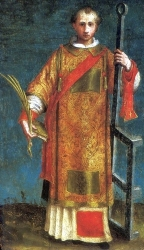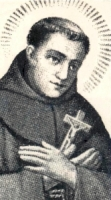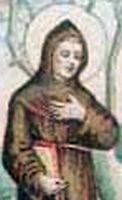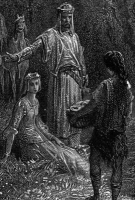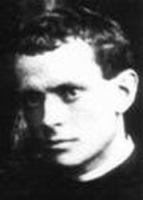St. Thiento & Companions
Saint Thiento and Companions were an abbot and six of his monks who were martyred by the Magyars of Hungary during an invasion in 955.
Thiento was the abbot of the monastery of St. Michael in Metten, Bavaria, Germany. The Magyars invaded the region in 955 and laid siege to the monastery. Thiento and his monks refused to surrender, and they were all killed by the Magyars.
The Magyars were a nomadic people who originated in the Ural Mountains. They were known for their fierceness and their skill in warfare. They invaded Europe several times in the 9th and 10th centuries, and they caused widespread destruction.
The martyrdom of Thiento and his companions was a great loss to the Church. They were all men of great faith and courage, and they died for their beliefs. Their sacrifice helped to inspire others to resist the Magyars and to defend the Christian faith.
Thiento and his companions were canonized as saints in the 12th century
The feast day of Saint Thiento and Companions is celebrated on August 8 and August 10.
The reason for the dual feast day is that the original date of their martyrdom was August 8, but their relics were not discovered until August 10. The Church decided to celebrate their feast day on both days to commemorate both their martyrdom and the discovery of their relics.
The Catholic Church also has a tradition of celebrating the feast day of a saint on the anniversary of their death, regardless of when their relics were discovered. This is why Saint Thiento and Companions are also celebrated on the anniversary of their death, which is September 10.
St. James of Manug
Saint James of Manug was a Christian martyr who lived in Egypt during the 4th century AD. He was a native of Manug, a village in the Absu area of Lower Egypt. He studied at Absu and became a devout Christian.
During a period of Christian persecution, James was arrested and brought to Farama, where he was tortured and eventually beheaded. He was martyred along with two other Christians, Abraham and John of Samanoud.
The feast day of Saint James of Manug is celebrated on August 10 in the Coptic Church, or August 11 in the Ethiopian Orthodox Tewahedo Church. He is remembered for his courage and his willingness to die for his faith.
St. Acrates (Aragawi)
St. Acrates (also known as Aragawi) was an Ethiopian saint who lived in the 6th century. He was a companion of St. Jacob of Mahdjudh and St. Entheus, and he was converted to Christianity by his brother Entheus.
Acrates was born into a pagan family in the town of Axum, Ethiopia. He was a skilled hunter and a talented musician. One day, he was hunting in the forest when he came across a group of Christians who were celebrating Mass. He was impressed by their faith and their joy, and he asked them to teach him about Christianity.
The Christians were happy to teach Acrates, and he quickly converted to Christianity. He was baptized and given the name Acrates, which means "the unconquered." Acrates then dedicated his life to serving God and spreading the Christian faith.
Acrates traveled throughout Ethiopia, preaching the gospel and ministering to the poor and sick. He was known for his humility, his compassion, and his love for God. He also had a gift for healing, and he is said to have performed many miracles.
Acrates eventually died a martyr's death. He was arrested by the local authorities for his Christian beliefs, and he was tortured and executed. His feast day is celebrated on August 8.
The feast day of St. Acrates is celebrated on August 8 and August 10. The reason for the two feast days is that there are two different traditions about his death.
According to one tradition, Acrates was tortured and executed on August 8. His body was then buried in a secret location, but it was later discovered and moved to a church in Axum. The feast day of August 8 commemorates the day of his death and burial.
According to the other tradition, Acrates was tortured and executed on August 10. His body was then burned, but his ashes were collected by his followers and buried in a church in Mahdjudh. The feast day of August 10 commemorates the day of his death and burial.
Saint Lawrence of Rome
புனிதர் லாரன்ஸ்
திருத்தொண்டர், மறைசாட்சி:
பிறப்பு: டிசம்பர் 26, 225
வலென்சியா அல்லது ஒஸ்கா, ஹிஸ்பானியா (தற்போதைய ஸ்பெயின்)
இறப்பு: ஆகஸ்ட் 10, 258
ரோம் (Rome)
ஏற்கும் சமயம்:
ரோமன் கத்தோலிக்க திருச்சபை
கிழக்கு மரபுவழி திருச்சபை
ஆங்கிலிகன் சமூகம்
லூதரனியம்
முக்கிய திருத்தலம்:
புனிதர் லாரன்ஸ் ஃபுவோரி லெ முரா பேராலய திருத்தலம், ரோம்
நினைவுத் திருவிழா: ஆகஸ்ட் 10
பாதுகாவல்:
கனடா (Canada), இலங்கை (Sri Lanka), நகைச்சுவையாளர்கள் (Comedians), நூலகர்கள் (Librarians), மாணவர்கள் (students), சுரங்கத் தொழிலாளர்கள் (miners), சமையல்காரர்கள் (Chefs), ரோஸ்டர்ஸ் (Roasters), ரோம் (Rome), ரோடர்டாம் (நெதர்லாந்து) (Rotterdam (Netherlands), ஹூஸ்கா (ஸ்பெயின்) (Huesca (Spain), சான் லாரென்ஸ் (San Lawrenz), கோசோ மற்றும் பிர்யூ (மால்டா) (Gozo and Birgu (Malta), பாராங்கை சான் லோரென்சோ சான் பப்லோ (பிலிப்பைன்ஸ்) (Barangay San Lorenzo San Pablo (Philippines), ஏழை (Poor), தீயணைப்பு வீரர்கள் (Firefighters).
புனிதர் லாரன்ஸ், “திருத்தந்தை இரண்டாம் சிக்ஸ்டஸின்” (Pope Sixtus II) கீழே ரோம் நகரில் பணியாற்றி, ரோமப் பேரரசன் “வலேரியன்” (Roman Emperor Valerian) என்பவனது ஆட்சிக் காலத்தில் நடந்த கிறிஸ்தவ துன்புருத்தல்களின்போது கி.பி. 258ம் ஆண்டு கொல்லப்பட்ட ஏழு திருத்தொண்டர்களுள் (Deacon) ஒருவர் ஆவார்.
மரபுகளின்படி, மறைசாட்சிகள் – புனிதர் “ஒரேன்ஷியஸ்” (St Orentius) மற்றும் புனிதர் “பேஷியன்ஷியா” (St Patientia) ஆகியோர் இவரது பெற்றோர் என நம்பப்படுகிறது.
இவர், கிரேக்க குடியும், மிகவும் பிரபலமான மற்றும் மிகவும் மதிப்புமிக்க ஆசிரியர்களுல் ஒருவரும், எதிர்கால திருத்தந்தையுமான இரண்டாம் சிக்ஸ்டசை” (Pope Sixtus II) தற்போதைய “சரகோஸா” (Zaragoza) எனுமிடத்தில் சந்தித்தார். இறுதியில் இருவரும் ஸ்பெயின் (Spain) நாட்டை விட்டு, ரோம் (Rome) நகர் புறப்பட்டுச் சென்றனர். கி.பி. 257ம் ஆண்டு, சிக்ஸ்டஸ் திருத்தந்தையானபோது, அவர் லாரன்ஸையும் இன்னும் ஆறு பேரையும் திருத்தொண்டர்களாக (Deacon) அருட்பொழிவு செய்வித்தார். லாரன்ஸ் இளைஞராக இருப்பினும், அவர்களில் முதன்மைத் திருத்தொண்டராக (Archdeacon of Rome) நியமித்தார்.
ரோமானிய அதிகார வர்க்கம், விதிமுறை ஒன்றினை நிறுவியதாக “கர்தாஜ்” ஆயரான (Bishop of Carthage) “புனிதர் சைப்ரியன்” (St. Cyprian) குறிப்பிடுகிறார். அந்த விதிமுறையில், கண்டிக்கப்பட்ட அனைத்து கிறிஸ்தவர்களும் தூக்கிலிடப்பட வேண்டுமென்றும், அவர்களின் பொருட்கள் மற்றும் சொத்துக்கள் பேரரசின் கருவூலத்தால் பறிமுதல் செய்யப்பட வேண்டுமென்றும் குறிப்பிடப்பட்டுள்ளதாக கூறுகிறார்.
“பேரரசன் வலேரியன்” (Emperor Valerian), கி.பி. 258ம் ஆண்டு, ஆகஸ்ட் மாத தொடக்கத்தில், அனைத்து ஆயர்கள், குருக்கள் மற்றும் திருத்தொண்டர்கள் அனைவரும் உடனடியாக தூக்கிலடப்படவேண்டும் என்ற உத்தரவினை வெளியிட்டான். கி.பி. 258ம் ஆண்டு ஆகஸ்ட் மாதம் ஆறாம் தேதி, “புனிதர் கல்லிக்ஸ்டஸின்” (Cemetery of St Callixtus) கல்லறையில் வழிபாடு நடத்திக்கொண்டிருந்த திருத்தந்தை “இரண்டாம் சிக்ஸ்டஸ்” (Pope Sixtus II) பிடிக்கப்பட்டு, உடனடியாக தூக்கிலிடப்பட்டார்.
சிக்ஸ்டசின் மரணத்தின் பின்னர், திருச்சபையின் சொத்துக்கள் அனைத்தையும் திருப்பி ஒப்படைக்க வேண்டுமென ரோம தலைமை அதிகாரி (Prefect) கட்டளையிட்டான். சம்பவங்களின் ஆரம்ப ஆதாரமாக இருந்த புனிதர் “அம்ப்ரோஸ்” (St Ambrose), சொத்துக்களை ஒன்று திரட்ட தமக்கு மூன்று நாட்கள் அவகாசம் வேண்டுமென லாரன்ஸ் கேட்டதாகவும், இயன்றவரை சொத்துக்களை வேக வேகமாக ஏழைகளுக்கு பகிர்ந்தளித்ததாகவும் கூறுகிறார். சொத்துக்கள் ரோம தலைமை அதிகாரியின் (Prefect) கைகளுக்கு போய் விடக்கூடாதே என்ற அவசரம் அவரது வேகத்திலிருந்தது என்கிறார்.
மூன்றாவது நாள், ஒரு சிறு குழுவை தலைமை தாங்கி வந்த லாரன்ஸ், தலைமை அதிகாரி முன்னிலையில் ஆஜரானதாக கூறுகிறார். திருச்சபையின் சொத்துக்களை ஒப்படைக்குமாறு உத்தரவிடப்பட்டபோது, அவர் தம்முடன் வந்திருந்த எளியவர்கள், ஊனமுற்றோர், பார்வையற்றோர் மற்றும் வேதனையால் துன்புருவோரை அதிகாரியின் முன்னிறுத்தி, இவர்களே திருச்சபையின் உண்மையான சொத்துக்கள் என்றார். “திருச்சபை உண்மையிலேயே செல்வம் மிகுந்தது; உங்களுடைய பேரரசனை விட எவ்வளவோ செல்வம் உள்ளது” என்று, லாரன்ஸ் தலைமை அதிகாரியிடம் அறிக்கையிட்டார். இத்தகைய அறைகூவல், லாரன்ஸை நேரடியாக மரணத்தின் வாயிலுக்கு இட்டுச் சென்றது. கடும் கோபமடைந்த தலைமையதிகாரி, தாம் ஏற்கனவே தயாரித்து வைத்திருந்த, இறைச்சி போன்றவற்றை சுடுவதற்கு பயன்படும் கம்பி போன்ற பெரிய அளவிலான சூடான இரும்பு கம்பிகளில் லாரன்ஸை படுக்கவைத்தான். நெடு நேர வேதனை அனுபவித்த லாரன்ஸ், சிரித்த முகத்துடன், “இந்த பக்கம் வெந்துவிட்டது; மறுபக்கம் திருப்பி போடு” என்றார்.
மரபுப்படி, புனித லாரன்ஸை கௌரவிக்கும் விதமாக, பேரரசர் “முதலாம் கான்ஸ்டன்டைன்” (Emperor Constantine I) ஒரு சிற்றாலயம் அமைத்தார். இது ரோம் நகரின் ஏழு திருப்பயண ஆலயங்களுல் ஒன்றாக துவக்கக்காலம் முதலே கருதப்பட்டது. இவ்வாலயத்தை திருத்தந்தை “முதலாம் டமாஸ்கஸ்” (Pope Damasus I) சீரமைத்து “புனித லாரன்ஸ் பேராலயமாக” (Basilica di San Lorenzo fuori le Mura) மாற்றினார். புனிதர் லாரன்ஸ் மறைசாட்சியாக மரித்த இடத்தில், “புனித லாரன்ஸ் சிறு பசிலிக்கா” (Minor Basilica of San Lorenzo in Panisperna) உருவாக்கப்பட்டது. லாரன்ஸ் மறைசாட்சியாக உபயோகப்பட்ட இரும்புக்கம்பி, அங்கேயே வைக்கப்பட்டுள்ளது.
Also known as
Laurence, Laurent, Laurentius, Lorenço, Lorenzo
Profile
Third-century archdeacon of Rome, distributor of alms, and "keeper of the treasures of the church" in a time when Christianity was outlawed. On 6 August 258, by decree of Emperor Valerian, Pope Saint Sixtus II and six deacons were beheaded, leaving Lawrence as the ranking Church official in Rome.
While in prison awaiting execution Sixtus reassured Lawrence that he was not being left behind; they would be reunited in four days. Lawrence saw this time as an opportunity to disperse the material wealth of the church before the Roman authorities could lay their hands on it. On 10 August Lawrence was commanded to appear for his execution, and to bring along the treasure with which he had been entrusted by the pope. When he arrived, the archdeacon was accompanied by a multitude of Rome's crippled, blind, sick, and indigent. He announced that these were the true treasures of the Church. Martyr.
Lawrence's care for the poor, the ill, and the neglected have led to his patronage of them. His work to save the material wealth of the Church, including its documents, brought librarians and those in related fields to see him as a patron, and to ask for his intercession. And his incredible strength and courage when being grilled to death led to his patronage of cooks and those who work in or supply things to the kitchen. The meteor shower that follows the passage of the Swift-Tuttle comet was known in the middle ages as the "burning tears of Saint Lawrence" because they appear at the same time as Lawrence's feast.
Born
at Huesca, Spain
Died
• cooked to death on a gridiron on 10 August 258 in Rome, Italy
• tradition says that the ashes of his burned body were dispersed by the winds, and appear at different places around the world on his feast day
• buried in the cemetery of Saint Cyriaca on the road to Tivoli, Italy
• tomb was later opened by Pelagius to inter the body of Saint Stephen the Martyr
• his mummified head is enshrined at the Quirinal Chapel of the Vatican Apostolic Library in Rome
• other relics and the gridiron believes to have been his deathbed are enshrined in the crypt of the Basilica of San Lorenzo Outside the Walls, Rome
• his garments are enshrined in Our Lady’s Chapel in the Lateran Palace, Rome
Blessed Amadeus of Portugal
Also known as
• Amadeus Menez de Silva
• Amedeus....
• João de Menezes da Silva
• João Mendes de Silva
• Peter John Silva Meneses
Profile
Born to the Portugese nobility, the youngest of eleven children of Rui Gomes, the Count of Viana, and Isabel de Menezes; brother of Saint Beatrice da Silva Meneses. Courtier to Empress Eleonaora of Portugal. Married briefly. Monk at the Hieronymite monastery of Santa María de Guadalupe for ten years. Entered the Franciscans in 1453 in Assisi, Italy as a lay brother. Hermit. Ordained in 1459. Founded the monastery Virgin of Peace near Milan, Italy and led a community under strict Franciscan rules; they were known as the Amadeistene, Amadeeërs or Marignano reform, and at one point there were 28 houses following their example, but all eventually merged with the Franciscans. Wrote on prophesy, and a commentary on the Book of Revelations. Amadeus's work was praised by Pope Sixtus IV, King Ferdinand the Catholic of Aragon, and Saint Louis IX of France.
Born
1420 in Morocco as João de Menezes da Silva
Died
• 10 August 1482 in Milan, Italy of natural causes
• buried under the high altar of his monastery in Milan
Saint Bessus
Also known as
Besso, Besse
Profile
Soldier of the Theban Legion. Convert to Christianity. He escaped the massacre of the Legion and became an evangelist in the mountain district of Val Soana. Reported to be a miracle worker and able to heal by prayer. Martyr.
Because of the understandably poor records from the period, and the similarity of his name both to other evangelists in the region and to a pre-Christian god, Bessus has figured into a lot of folk tales, practices and later legends.
Died
• thrown from Mount Fautenio c.286 Campiglia Soana, Turin, Italy
• the spot where he landed (and died) left an impression in the rock, and a shrine was soon built over it
• relics taken to Ozegna in the 9th century and enshrined a chapel now known as the Beata Vergine del Convento e del Bosco
• relics later taken to the cathedral of Virea, Italy and enshrined in a sacrophagus
• relics later enshrined in a side altar in the cathedral with those of several other martyr saints
Blessed Archangelus Piacentini
Also known as
Arcangelo Placenza
Profile
Born to the nobility. Known as a quiet and pious child, it was no surprise when he went to live as a hermit in a cave near the church of Santa Maria dei Giubino in Sicily. His reputation for holiness spread, and the young hermit attracted would-be spiritual students - which caused him to move to Alcamo, Sicily to get away from them. His reputation went with him, and he was asked to restore broken down shelters for the poor in the area. The job finished, Arcangelo returned to his hermitage. However, Pope Martin V, working to restore papal authority, decreed that all hermits in Sicily should join approved religious orders; and so Arcanglo joined the Franciscans in Palermo, receiving the habit from Blessed Matthew of Girgenti. Priest. Assigned to establish a new Franciscan house in Alcamo; he used part of the structures he had helped to restore. He led both his brothers and the laity by his example, supported Franciscans throughout Sicily, turned down the bishopric in Alcamo, and spent his last days helping Blessed Matthew.
Born
c.1390 at Calatafimi, Sicily, Italy
Died
10 August 1460 in Alcamo, Sicily, Italy of natural causes
Beatified
9 September 1836 by Pope Gregory XVI (cultus confirmed)
Saint Blane
Also known as
Blaan, Blan, Blain
Profile
Nephew of Saint Cathan. Studied in Ireland under Saint Comgall of Bangor, Saint Kenneth, and Saint Canice. Monk. After seven years, he returned to Scotland; tradition says he travelled in a boat without oars or rudder, but that it took him safely home. Monk at the monstery founded by Cathan; ordained by his uncle. Missionary to the Scottish Picts. Bishop of Kingarth, Scotland, ordained by Cathen. Pilgrim to Rome to seek papal blessing on his bishopric; made the return trip entirely on foot.
Reputed miracle worker, including bringing the young son of a British chief back to life, curing the blind, and lighting fire by making small bolts of lightning jump between his fingers. Devotion to Blane soon followed his death, was widespread in Scotland, and very popular; his monastery became the site of the cathedral of Dunblane, Scotland and there were several churches with his name.
Born
6th century at Isle of Bute, Scotland
Died
• c.590 at Kingarth, Isle of Bute, Scotland of natural causes
• buried in Dunblane, Scotland which was named for him
Blessed Lazare Tiersot
Profile
Joined the Carthusians on 18 December 1769 at the monastery of Fontenay, France. Priest. Served as vicar of his house until June 1791 when the monastery was suppressed by the civil authorities of the French Revolution. Arrested on 19 April 1793 for refusing to take the oath that would have switched his allegience from the Vatican to the civil authorities of the Revolution. Imprisoned on a ship in the harbor of Rochefort, France and left to die. There he ministered to other prisoners, hearing confessions, doing what little he could for the sick. One of the Martyrs of the Hulks of Rochefort.
Born
29 March 1739 in Semur-en-Auxois, Diocese of Sens-Auxerre, Côte-d'Or, France
Died
• 10 August 1794 aboard the prison ship Washington, in Rochefort, Charente-Maritime, France of a fever
• buried on the island of Aix, France
Beatified
1 October 1995 by Pope John Paul II
Blessed Franciszek Drzewiecki
Additional Memorial
12 June as one of the 108 Martyrs of World War II
Profile
Orionist friar. After studies at the mother-house in Tortona, Italy, he was ordained on 6 June 1936. Returning to Poland, he taught at the college of Zdunska Wola. Parish priest in Wloclawek, Poland. Arrested on 7 November 1939 and condemned to forced labour at the Dachau concentration camp farms during the Nazi persecutions; he kept consecrated hosts in a small box he wore around his neck, and spent his time in the fields in Eucharistic adoration. Martyr.
Born
26 February 1908 in Zduny, Lódzkie, Poland
Died
gassed on 10 August 1942 at the prison camp at Dachau, Oberbayern, Germany
Beatified
13 June 1999 by Pope John Paul II in Warsaw, Poland
Blessed François François
Also known as
Sébastien of Nancy
Profile
Franciscan Capuchin priest. Imprisoned on a ship in the harbor of Rochefort, France and left to die during the anti-Catholic persecutions of the French Revolution. One of the Martyrs of the Hulks of Rochefort.
Born
17 January 1749 in Nancy, Meurthe-et-Moselle, France
Died
10 August 1794 aboard the prison ship Deux-Associés, in Rochefort, Charente-Maritime, France
Beatified
1 October 1995 by Pope John Paul II
Blessed Claude-Joseph Jouffret de Bonnefont
Profile
Sulpician priest. Imprisoned on a ship in the harbor of Rochefort, France and left to die during the anti-Catholic persecutions of the French Revolution. One of the Martyrs of the Hulks of Rochefort.
Born
23 December 1752 in Gannat, Allier, France
Died
10 August 1794 aboard the prison ship Deux-Associés, in Rochefort, Charente-Maritime, France
Beatified
1 October 1995 by Pope John Paul II
Blessed Edward Grzymala
Additional Memorial
12 June as one of the 108 Martyrs of World War II
Profile
Priest in the diocese of Wloclawek, Poland. Imprisoned and murdered in the Nazi persecutions. Martyr.
Born
19 September 1906 in Kolodziaz, Podlaskie, Poland
Died
gassed on 10 August 1942 at the prison camp at Dachau, Oberbayern, Germany
Beatified
13 June 1999 by Pope John Paul II in Warsaw, Poland
Blessed Augustine Ota
Also known as
Augustinus Ota
Profile
Worked as a catechist, helping Jesuit missionaries. Imprisoned at Ikinoshima for his faith. While imprisoned, he was received into the Jesuits. Martyr.
Born
1572 in Ojika, Goto-retto, Nagasaki, Japan
Died
beheaded 10 August 1622 at Ikinoshima, Japan
Beatified
7 May 1867 by Pope Blessed Pius IX
Saint Gerontius
Also known as
Geraint
Profile
King of Damnonia (in modern Devon, England). He and his wife Enid are the subjects of romantic legends in the region.
Died
killed c.508 in battle against Saxons
Saint Asteria of Bergamo
Also known as
Hesteria
Profile
Sister of Saint Grata of Bergamo. Worked to provide Christian burial for martyrs. Executed by Diocletian for doing it. Martyr.
Died
• beheaded c.307
• venerated in Bergamo, Italy
Saint Agilberta of Jouarre
Also known as
Aguilberta, Gilberta
Profile
Related to Saint Ebrigisil, Saint Ado of Jouarre, and Saint Agilbert of Paris. Nun. Abbess of Jouarre Abbey c.660.
Died
c.680
Blessed Hugh of Montaigu
Profile
Nephew of Saint Hugh of Cluny, who was his teacher and spiritual director. Benedictine monk at Cluny Abbey in France. Bishop of Auxerre, France in 1096.
Died
1136 of natural causes
Saint Deusdedit the Cobbler
Profile
Poor layman shoemaker in sixth-century Rome, Italy. Pope Saint Gregory the Great wrote that every Saturday Deusdedit would give away all the profits from that week to the poor.
Saint Bettelin
Also known as
Bertram
Saint Bettelin's feast day is on August 10. He was an Anglo-Saxon hermit and saint who lived in the 8th century. He is the patron saint of Stafford, England.
Bettelin was born in Mercia, England, around the year 700. He was a nobleman who renounced his wealth and status to become a hermit. He lived in a cave near the River Sow in Staffordshire. Bettelin is said to have had the gift of healing, and he was often sought out by people who were sick or injured.
Bettelin died in 780. His relics were enshrined in the Church of St Mary and St Ethelbert in Stafford. His feast day is celebrated on August 10.
Died
• 8th century
• relics enshrined in Ilam, Staffordshire, England
Saint Aredius of Lyons
Also known as
Aregius, Arige
He was an Irish monk and missionary who lived in the 6th century. He is the patron saint of the city of Yrieix-la-Perche in France.
Aredius was born in Ireland in the early 6th century. He was a member of the Céli Dé, a group of Irish monks who were dedicated to the monastic life. Aredius eventually left Ireland to become a missionary in Gaul.
Aredius settled in the town of Yrieix-la-Perche, where he founded a monastery. He is said to have had the gift of healing, and he was often sought out by people who were sick or injured. Aredius also worked to convert the local people to Christianity.
Aredius died in Yrieix-la-Perche in the early 6th century. He is remembered for his holiness and his dedication to the Christian faith. His feast day is celebrated on August 25 in Yrieix-la-Perche and in other parts of France.
Died
c.614
Saint Bassa of Carthage
Saint Bassa of Carthage is August 10. She was a nun and martyr who died in Carthage in North Africa during the persecutions of Diocletian in the early 4th century.
Bassa was born into a wealthy family in Carthage. She was well-educated and had a strong faith in Christ. She decided to become a nun and joined the convent of Saint Agatha in Carthage.
During the persecutions of Diocletian, Bassa was arrested and tortured for her faith. She refused to renounce Christ and was eventually beheaded. She was one of many Christians who were martyred in Carthage during this time.
Bassa is considered a martyr for her faith. Her feast day is celebrated on August 10, the same day as the feast day of several other African martyrs, including Saint Cyprian of Carthage and Saint Perpetua of Carthage.
Died
in Carthage in North Africa
Martyrs of Alexandria
Profile
A large number of Christians who died in Alexandria, Egypt between 260 and 267 in the persecutions of Decius and Valerian, whose names have not come down to us, and who are commemorated together.
the Martyrs of Alexandria are also commemorated on August 10. This is because the exact dates of their martyrdom are not known, so the Church commemorates them on the nearest day that is not already taken by another saint.
The August 10 feast day is more commonly observed in the Eastern Orthodox Church, while the August 30 feast day is more commonly observed in the Roman Catholic Church. However, both feast days are a time to remember the courage and sacrifice of the Martyrs of Alexandria.
Martyrs of Rome
Profile
Group of 165 Christians martyred in the persecutions of Aurelian.
Died
274 in Rome, Italy
Martyred in the Spanish Civil War
Thousands of people were murdered in the anti-Catholic persecutions of the Spanish Civil War from 1934 to 1939.
• Blessed Antonio González Penín
• Blessed José Toledo Pellicer
• Blessed José Xavier Gorosterratzu Jaunarena
• Blessed Juan Martorell Soria
• Blessed Pedro Mesonero Rodríguez
• Blessed Victoriano Calvo Lozano
